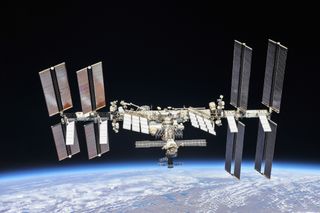Space debris forces astronauts on space station to take shelter in return ships
Seven astronauts on the International Space Station were forced to take shelter in their transport spacecraft early Monday (Nov. 15) when the station passed uncomfortably closed to orbital debris, according to reports.
The space junk passes began in the pre-dawn hours of Monday and the International Space Station has continued to make close passes to the debris every 90 minutes or so, according to experts monitoring the situation. Russia's space agency Roscosmos confirmed the space junk encounter with Space.com, though NASA has not yet commented on the situation either publicly or to Space.com.
"Thanks for a crazy but well-coordinated day, we really appreciated all the situational awareness you gave us," NASA astronaut Mark Vande Hei told NASA's mission control at Johnson Space Center in Texas during a check-in marking the end of the astronauts' day at about 12 p.m. EST (1700 GMT). "It was certainly a great way to bond as a crew, starting off our very first workday in space."
(Vande Hei himself has been in space since April, but four astronauts arrived at the space station on Thursday, Nov. 11.)
"We're looking forward to a calmer day tomorrow," he said.
Related: The worst space debris events of all time

During the conversation, mission control told the crew that they were receiving a schedule for all the debris field passes that would occur through Tuesday (Nov. 16), although the ground support would stop announcing the passes to allow the crew to sleep. Mission control also noted that tomorrow, crewmembers would need to continue closing the hatches to modules off the core of the space station during passes.
Get the Space.com Newsletter
Breaking space news, the latest updates on rocket launches, skywatching events and more!
By about 9:30 a.m. EST (1430 GMT), the situation aboard the space station had returned to normal, according to a statement from Roscosmos.
"Currently, the International Space Station crew is routinely performing operations according to the flight program," the Roscosmos press office told Space.com in an email. "The orbit of the object, which forced the crew today to move into spacecraft according to standard procedures, has moved away from the ISS orbit, the station is in the green zone."
The U.S. government has not publicly stated what created the debris field troubling the International Space Station on Monday. However, the federal government has confirmed that Russia conducted an anti-satellite test that created debris and could threaten the space station and other spacecraft in orbit.
"Today, the Russian Federation recklessly conducted a destructive satellite test of a direct ascent anti-satellite missile against one of its own satellite," U.S. State Department spokesperson Ned Price said during a news conference. "This test will significantly increase the risk to astronauts and cosmonauts on the International Space Station, as well as to other human spaceflight activities."
Price noted that the anti-satellite test created more than 1,500 pieces of orbital debris large enough to track, in addition to "hundreds of thousands of pieces of smaller orbital debris."
NASA, Roscosmos and their partners regularly monitor a safety perimeter around the space station that is shaped like a pizza box and extends just over 15 miles (25 kilometers) around the space station and half a mile (0.75 km) above and below. Station officials often move the space station to dodge debris coming into that zone, if enough time allows. That occurred last week, when debris from a 2013 Chinese anti-satellite test passed near the station on Nov. 10.
Related: Space debris images & cleanup concepts
According to a live audio feed from the International Space Station, the facility's most recent encounter with the "debris field" occurred at about 9:50 a.m. EST (1450 GMT) and lasted about six minutes.
Space debris expert Jonathan McDowell of the Harvard Center for Astrophysics said on Twitter that the first encounter between the space station and the space junk occurred at 2:06 a.m. EST (0706 GMT) and lasted about 10 minutes.
"Details are sketchy," space journalist William Harwood of CBS News tweeted, "but the 7-member crew of the ISS took refuge in their Soyuz MS-19 and Crew Dragon Endurance spacecraft earlier today as a precaution due a predicted close pass to (or through) a 'debris cloud' resulting from a satellite breakup."
It is standard space station procedure for astronauts to pile into their vehicles in case of any kind of emergency in case they need to evacuate the space station.
Seven international astronauts are currently living and working in the orbital laboratory: NASA astronauts Vande Hei, Raja Chari, Thomas Marshburn and Kayla Barron are joined by Russian cosmonauts Anton Shkaplerov and Pyotr Dubrov and German astronaut Matthias Maurer of the European Space Agency (ESA).
Chari, Marshburn, Barron and Maurer are newcomers to the station, having arrived on Thursday (Nov. 11) aboard a SpaceX Crew Dragon capsule dubbed Endurance.
Editor's note: This story was updated at 12:20 p.m. EST to include comments from crewmembers and mission control and at 2:45 p.m. EST to include comments from the U.S. State Department. Email Meghan Bartels at mbartels@space.com or follow her on Twitter @meghanbartels. Follow us on Twitter @Spacedotcom and on Facebook.
Join our Space Forums to keep talking space on the latest missions, night sky and more! And if you have a news tip, correction or comment, let us know at: community@space.com.

Meghan is a senior writer at Space.com and has more than five years' experience as a science journalist based in New York City. She joined Space.com in July 2018, with previous writing published in outlets including Newsweek and Audubon. Meghan earned an MA in science journalism from New York University and a BA in classics from Georgetown University, and in her free time she enjoys reading and visiting museums. Follow her on Twitter at @meghanbartels.